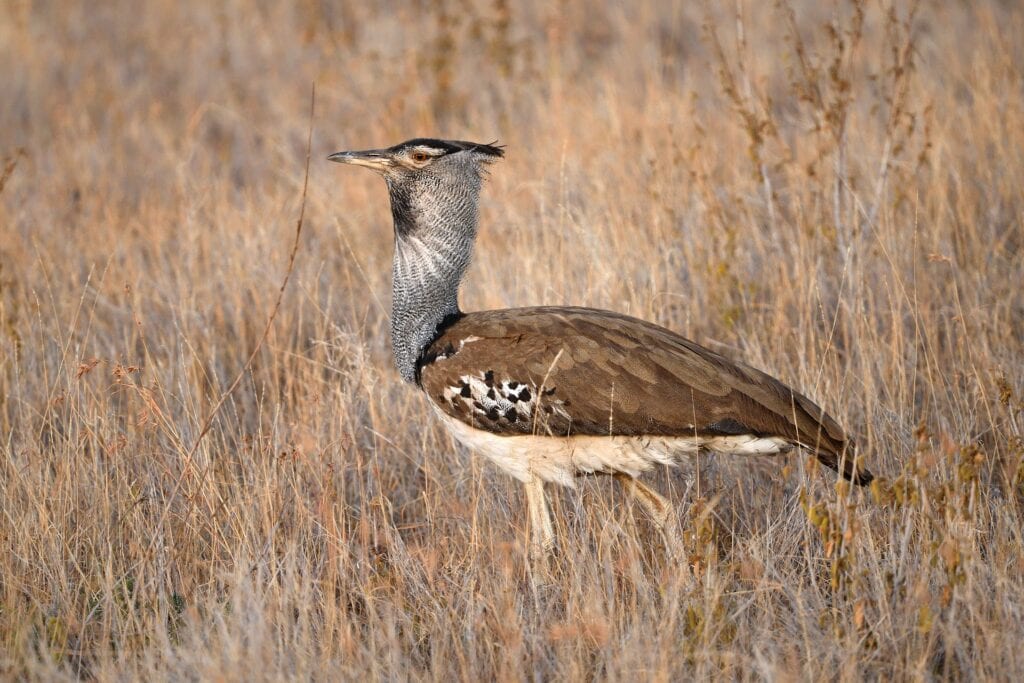Is that a miniature ostrich? An overgrown turkey? Some kind of desert crane? Perhaps a long forgotten feathered dinosaur? Nope! It’s a bustard. There are twenty-three species of bustard throughout Southern Europe, Asia, Africa, Australia, and New Guinea. These large terrestrial birds are some of the heaviest birds around which are still capable of flight. (1)(2) Built for running, bustards have long powerful legs that end in three-toed feet. Although they are built compactly enough to be able to achieve flight, bustards are shockingly large with heights reaching up to almost five feet amongst the males of certain species. (3)
Bustards are fascinating birds whose impact has managed to extend beyond the regions where they are found. French missionaries in the seventeenth century mentioned “bustards” on their list of birds that were abundant in the region that is now known as Illinois. There are no bustards in North America currently and there is no evidence that they have ever lived in the Americas. Historians believe that the “bustard” that these settlers referred to may have been one of North America’s Wild Turkeys or Canada Geese. (4)
In any case, the bustard is a unique bird whose appearance is stunning and distinctive. Whether you are fascinated by these exceptional creatures, interested in the mythology of these large birds, or feel drawn to their mysterious allure, read on to learn more about the brilliance of the bustard!
Bustard Symbolism and Meaning
Bustards are quite remarkable birds whose more unusual traits have earned them several records. Both the Kori Bustard and the Great Bustard have been cited as the heaviest birds in the world that are still capable of flight. Furthermore, bustards are considered by some to be the most sexually dimorphic birds around. Sexual dimorphism refers to physical differences between males and females within a species. For example, peafowl are sexually dimorphic because only the peacocks have that bright fan of colorful feathers. Similarly, bustard males and females look quite a bit different from each other. (5)
In fact, female bustards can be up to four times smaller than their male counterparts depending upon the bustard species. (6) Amongst birds, this is often considered to be the greatest size difference between sexes. On account of their dramatic differences, bustards separate into male and female flocks and tend to live separately until the time comes to breed. (7) So, bustards may represent either masculinity or femininity as well as the balance between these two energies.
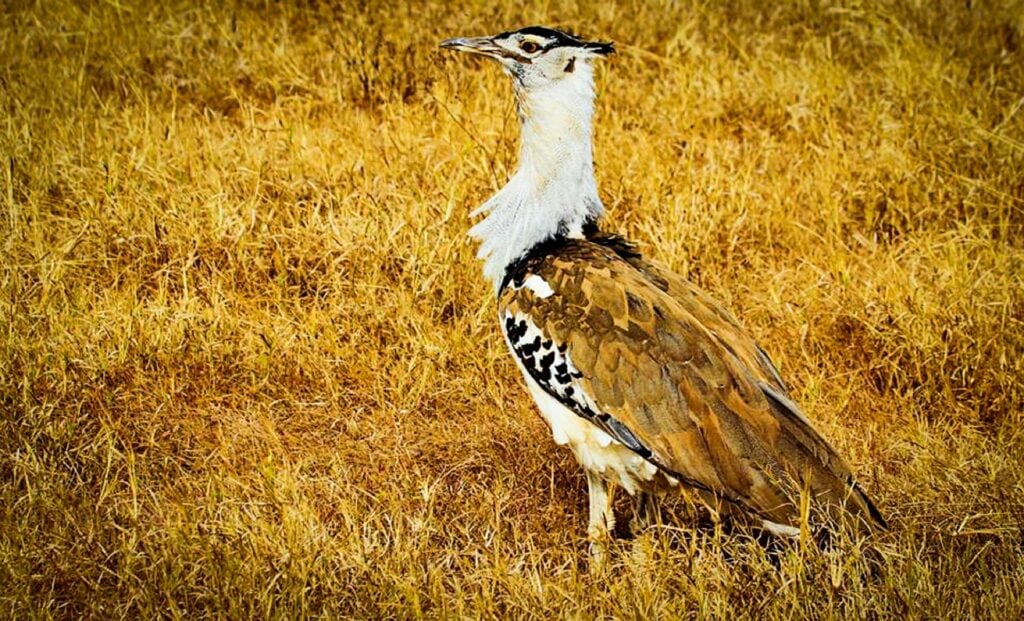
During the mating season, male bustards compete for female attention by fanning their tail feathers, inflating a pouch of skin on their neck referred to as an “esophageal pouch,” snapping their bills, bowing, and making low booming sounds. (8) At the end of this display, the successful male will move on, but the female will begin to nest. Bustards fledge quite early, but will remain under their mother’s care for as long as an entire year. Bustards, then, can be symbolically connected with competition, courtship, motherhood, and immaturity.
Male bustards live shorter lives on average than females. Although they choose to flock together, males can be extremely aggressive towards one another. Fierce hierarchies and tough competition makes life as a male bustard quite tough. Bustards may occasionally represent aggression, hierarchy, cruelty, and discord. (9)
Bustards are important figures in the mythology of the Khoe San people of South Africa. For the Khoe San, these birds represent medicine, healing, strength, leadership, and royalty.
Visiting diplomats often take part in extravagant hunting excursions targeting bustards in South Asia. These hunting expeditions are heavily criticized for exceeding quota limits, sometimes by up to ten times, for hunting this threatened species. Bustards breed quite slowly and experience high infant mortality, combined with hunting, poaching, and habitat loss, most bustards are under threat. In England and parts of Europe, the bustard has already become extinct and is being reintroduced from populations bred elsewhere. Unfortunately, bustard meat is highly sought after due to its supposed “aphrodisiac” qualities. So, bustards may also be connected with the plight of endangered species and the importance of conservation efforts when it comes to protecting afflicted species. (11)
Bustard Native American Symbolism
Bustards are not known to have been present in the Americas, but the bustard can be considered to resemble the Wild Turkey or the Ruffed Grouse; two very important Native American birds. Both of these birds are often connected with the warrior’s spirit and cleverness, so one might expect the bustard to be interpreted similarly. (12)(13)
Bustard in Dreams
Dreaming of a bustard is often indicative of a fear or insecurity that one is facing. Bustards are both skittish creatures and aggressive towards their own kind. Dreaming of these birds can indicate that one feels hostility or vulnerability with regards to their interpersonal relationships.
Bustards in dreams may also indicate the balance between one’s masculine and feminine energies. Dreaming of male and female bustards together can indicate harmony, but dreaming of the two in conflict with one another can indicate an imbalance in energies.
Dreaming of young bustards might indicate anxiety towards growing up and maturing. Young bustards hatch with the ability to walk and can fend for themselves in no time, yet they rarely survive to adulthood and will remain with their mothers for many more months than necessary. An adolescent bustard can represent the tumult of young adulthood.
Bustard Encounters and Omens
Encountering a bustard is a very lucky occurrence on account of the fact that bustards are quick on their feet, fearful of humans, and very vigilant. Few people get to catch a glimpse of wild bustards, so doing so can indicate patience and calm.
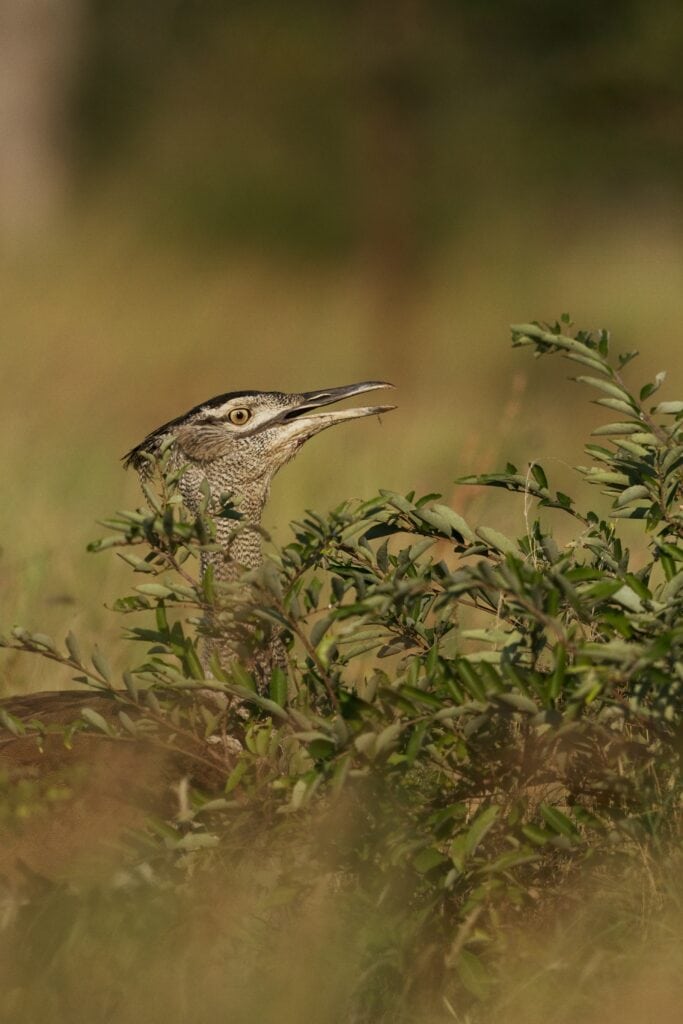
A bustard encounter may represent the importance of staying grounded and being true to one’s strengths. While bustards are absolutely capable of flight, these heavy birds rely mainly on their powerful legs to get by. Running is a much more natural activity to most bustards than flying. So, dreaming of a bustard might be a reminder to do what you are good at and not what you think that others expect you to do.
Bustard in Mythology & Folklore
Bustards don’t appear in mythology often, but they are commonly associated with healing and medicine. Below are the most prominent stories from mythology that include the bustard.
African Mythology:
South African Khoe San mythology suggests that the bustard had a special role in the creation of life. The Khoe San are not one cohesive people, so their mythologies vary quite a bit, but in some traditions, life began with a great fire started by the creator god. Before the fire, all animal traits floated around in the ether without a true form. The creator baked these traits in a great fire which brought order and life into the world. According to this legend, the Kori Bustard was the creator’s faithful servant and was responsible for fanning the flames of this life-giving fire with its massive wings. Further traditions suggest that the Kori Bustard is the chief or captain of the animal kingdom due to his majesty and his role as an agent of the creator god. (14)
Aborginal Mythology:
According to one Aboriginal myth, the bustard is responsible for the emu’s flightless-ness. The story of Dinewan the emu and Goomblegubbon the bustard begins with the mother bustard of the Goomblegubbon family stewing with jealousy over the mighty Dinewan emu family. Aware that she could not beat an emu in a true fight, the bustard decided to trick the emu and best her through cunning. So, the bustard decided to rid the emu of her wings. As the mother emu approached her, the mother bustard tucked her wings tight against her body and began to boast that she was an incredible bird even without wings. She laughed and proclaimed that she must be queen of the birds since she was so great that she didn’t need wings at all. Competitive fire flared in the emu’s heart and she removed her wings to prove that she was greater than the bustard. Immediately, the bustard began to gloat over how gullible the flightless emu was. So, the emu began to plot her revenge. One day when she brought her young to the watering hole, the emu had an idea. She hid ten of her babies and brought only the largest two. When the bustard saw the emu, she asked where all of her babies had gone. The emu explained that she wanted to ensure that her sons grew up strong, so she slew the weakest of her brood. That way her sons would have nobody to compete with and could grow stronger and bigger than any other bird. Not one to be outdone, the bustard selected her two strongest babies and killed the rest. She wanted her babies to grow just as strong as the emus, so ten of her babies would have to die so that her two biggest children could thrive. When the emu saw what the bustard had done, she began to gloat and revealed her ten hidden children. The bustard was distraught when she realized that she had been tricked, and she never challenged the emu again. So, the bustard may have tricked the emu out of her wings, but the emu got the last laugh and the bustard has very few young to this day. (15)
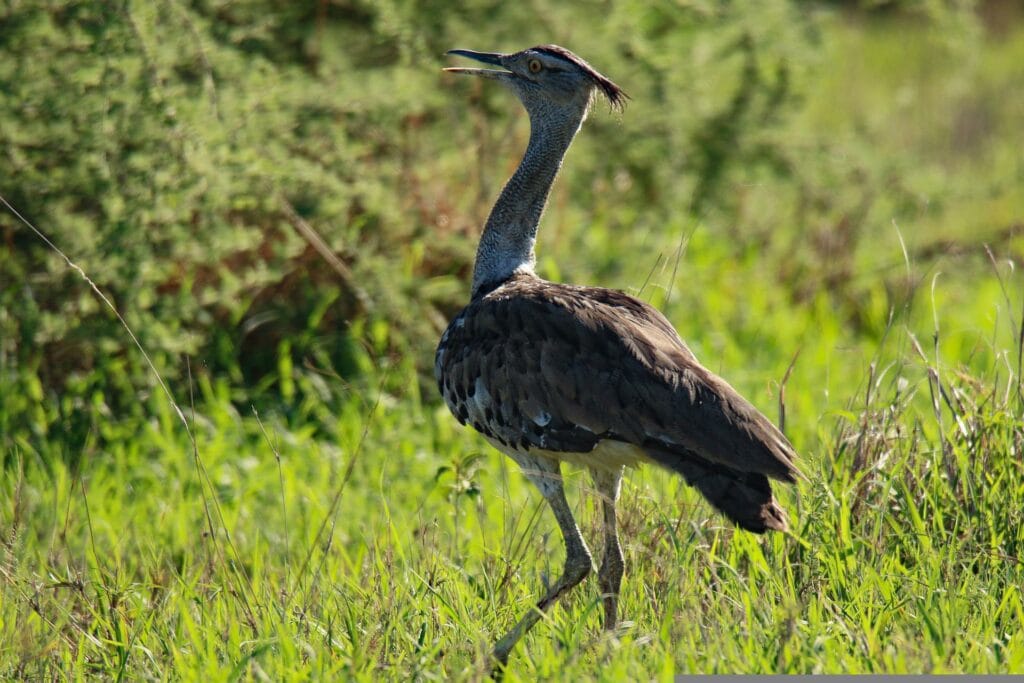
Bustard Spirit Animal
If your spirit animal is the bustard then you are likely a prickly person who prefers to have your own space. While not exactly “mean” at heart, people with the bustard as their spirit animal may be seen as mean by others on occasion. These sorts of misunderstandings arise when the bustard spirit animal senses an intrusion into their space or their privacy.
The bustard spirit animal is so defensive and reactionary because they are deeply vulnerable at heart and can be very fearful of letting others in or finding themselves in situations where they have no control. If controlling your environment is one way that you cope with feeling unsafe, then the bustard might just be your spirit animal.
The bustard spirit animal is actually much more empathetic than it seems, but because of extra sensitivity and a deep fear of being hurt by others, people with the bustard spirit animal can struggle with making connections.
Bustard Totem Animal
The bustard totem animal is strongly connected with competition, strength, and prowess. People with the bustard as their totem animal are often wildly ambitious and find lots of passion in fighting their way to an achievement. Ruthless at times, the bustard totem animal seeks victory above all else.
Competitive athletes and individuals with high-powered or lucrative career paths may find themselves especially drawn to the bustard totem animal.
The bustard totem animal is predominantly associated with typically “masculine” qualities, however women also experience the competitive energy that the bustard totem brings. Women with the bustard totem animal are calculating and focused with a very goal-driven mindset.
Bustard Power Animal
The bustard power animal is associated with medicine and healing. Perhaps because of the large size and evident physical strength of this bird, Native South Africans strongly associate the bustard with medicine and healing. Body parts from deceased bustards are used as folk medicine and believed to heal a variety of ailments and to boost an individual’s general constitution. Bustards are generally endangered, so obviously their use in folk medicine cannot be condoned, nevertheless, the bustard as a power animal is associated with healing properties.
While the bustard spirit is standoffish, the bustard power animal is much more nurturing. Beneath an outer shell that is difficult to approach lies a soul that is inherently empathetic and understanding. People with the bustard as their power animal have an intuitive ability to understand the needs of others and provide literal and spiritual support for growth and healing.
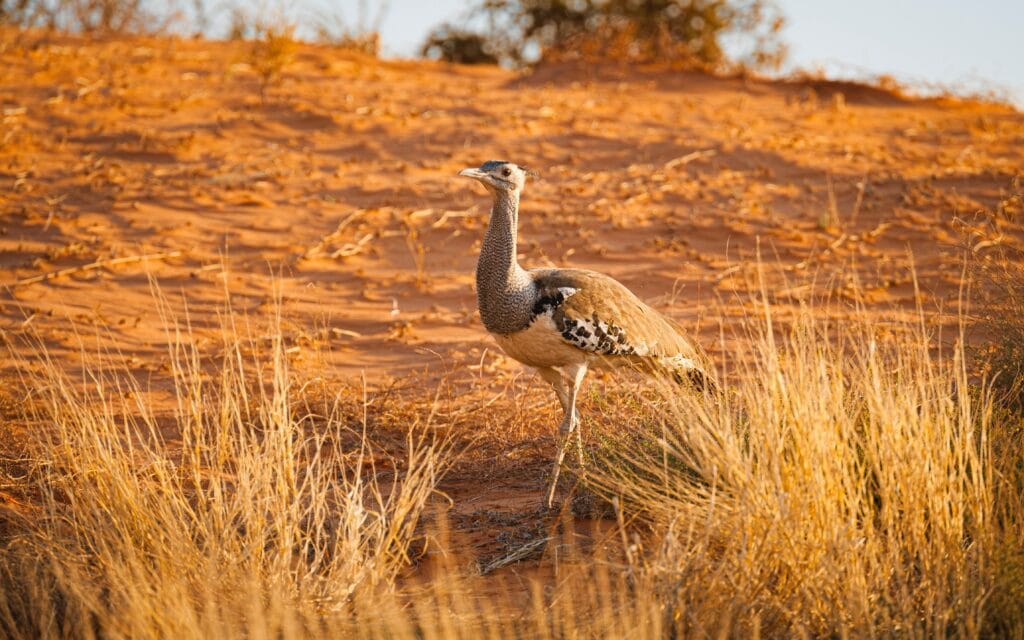
Bustard Tattoo Meaning
A bustard tattoo might be chosen to symbolize the ongoing struggles of earth’s endangered species. Bustards around the world are growing more and more scarce. Choosing a bustard tattoo can act as a reminder of what is at stake when nature’s biodiversity is not protected.
A bustard tattoo may also be chosen to represent either masculine or feminine energy. Because bustards are so sexually dimorphic, male and female bustards really embody their respective sexes.
Bustard tattoos may also represent balance, healing, competition, vulnerability, or grounded-ness.
Conclusion
Beautiful and strange, the bustard is an animal that many people don’t even know exists. Like feathered dinosaurs roaming the earth’s plains, these magnificent birds remind us of all of the majestic and diverse offerings that nature has to show us.

